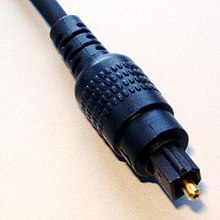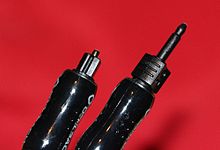TOSLINK
TOSLINK (abbreviation for TOShiba-LINK ) is a standardized fiber optic connection system originally developed by Toshiba for optical signal transmission in the range of up to around 20 Mbit / s . It has found widespread use in the digital transmission of audio signals in consumer goods, where it is used, for example, for transmission between components such as CD and DVD players and audio amplifiers or D / A converters .
The line code and the data formats transmitted are largely identical to the electrical signals in S / PDIF , so that simple converters can be used for conversion.
electric wire
A fiber optic cable made of transparent plastic ( PMMA or polycarbonate , see polymer optical fiber , POF for short) with a core diameter of 1 mm is used. The large diameter makes it possible to couple the radiation from light-emitting diodes with a focusing lens molded onto them - no laser diodes are required. With the same diameter, POF have a smaller bending radius, but higher attenuation than glass fiber-optic cables, the ranges are therefore limited to about 100 meters, in practice to about 10 meters. The cables are usually sold more expensive than copper cables.
Advantages disadvantages
The advantage of a fiber optic connection in audio technology is that it achieves potential separation of the device components and thus avoids ground loops . Fiber-optic cables are also insensitive to electrical and magnetic interference. Furthermore, interference emissions from cable-transmitted electrical digital signals are avoided. However, it happens that metal-reinforced TOSLINK cables are used to increase their robustness, which then cause hum loops in digital devices if the metal reinforcement is connected to ground at both cable ends. In addition, due to their physical properties, fiber optic cables are generally susceptible to tight bending radii (sharp edges, kinks).
development
TOSLINK was originally developed by Toshiba in 1983 in order to connect their CD players to their radio receivers, but it quickly caught on with CD players from other brands as well. Early TOSLINK systems used the raw digital data from CD players, but the S / PDIF standard has now established itself as the universal format for audio streams.
use
Initially, TOSLINK was mostly used to send data to MiniDisc or DAT recorders, but due to the decline in the number of devices and the simultaneous spread of computers and digital connections, this has increasingly become the standard for digital audio connections, also in the consumer sector. TOSLINK will u. a. used to connect DVD players or game consoles to Dolby Digital / dts ( home theater systems ) decoders . The connection of computers and network players to external D / A converters is also a common scenario, as music is increasingly being collected on hard drives.
The same connector system is also used with a different transmission protocol ( ADAT Lightpipe) in the recording studio . This means that up to 8 channels can be transmitted simultaneously.
A connection via TOSLINK is - although fiber optic technology can basically be used in both directions - only defined and possible in one direction.
Connector types
Another name for TOSLINK is F05 connector, which is the standard.
An alternative connector variant is the 3.5 mm miniplug connection. It is used when an analog electrical jack signal is output in the same output socket. A TOSLINK miniplug plug is then required for the connection, which has the shape of a conventional 3.5 mm jack plug, but is usually made of plastic and at its end encompasses the end face of the fiber optic cable. Many of today's notebooks have this output and use it to output Dolby Digital 5.1 surround sound, for example .
A decline can be observed. For example, Apple MacBooks and iMacs no longer have Toslink in the socket for headphones . An interface or sound card with TOSLINK output or an adapter (e.g. to HDMI ) connected via Thunderbolt or USB can be used as a replacement , depending on what the end device supports.
There are ready-made cables and adapters with all combinations of these two connector types. The optoelectronic components for sending and receiving are usually integrated directly into the sockets.
See also
literature
- Fiber-Optic Devices TOSLINK PRODUCT GUIDE Toshiba Corp. 2008 (English, PDF)
Web links
Individual evidence
- ↑ How to play high sample rate digital audio on Mac computers - Apple Support. Retrieved February 13, 2020 .
- ↑ The Mac audio ports - Apple Support. Retrieved February 13, 2020 .
- ↑ Does the new 2017 iMac have optical out via the 3.5 headphone jack? - Apple Community. Retrieved February 13, 2020 .
- ↑ Optical output available on iMac Retina 5k 2017? - Apple Community. Retrieved February 13, 2020 .


